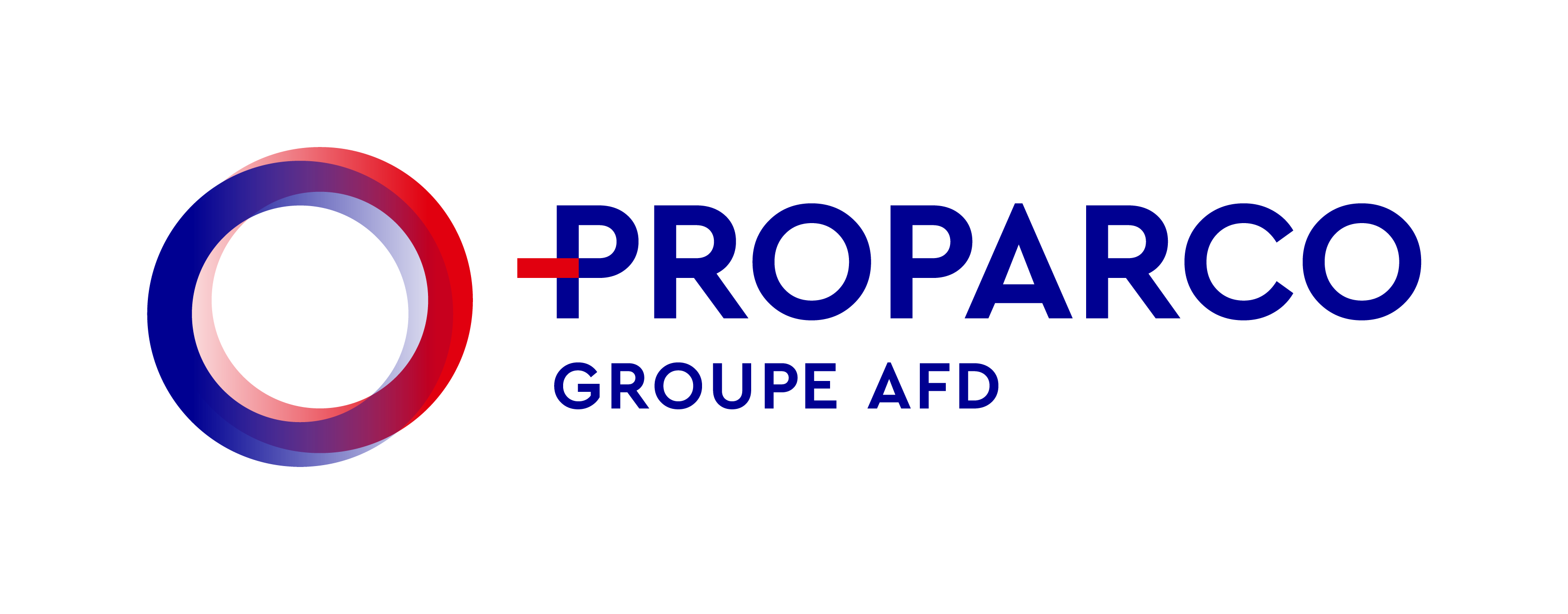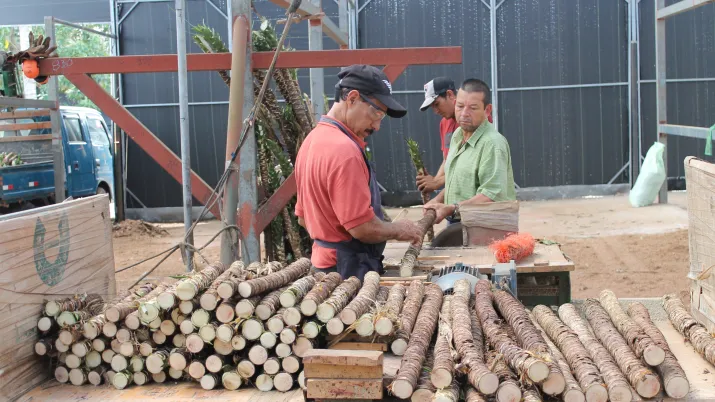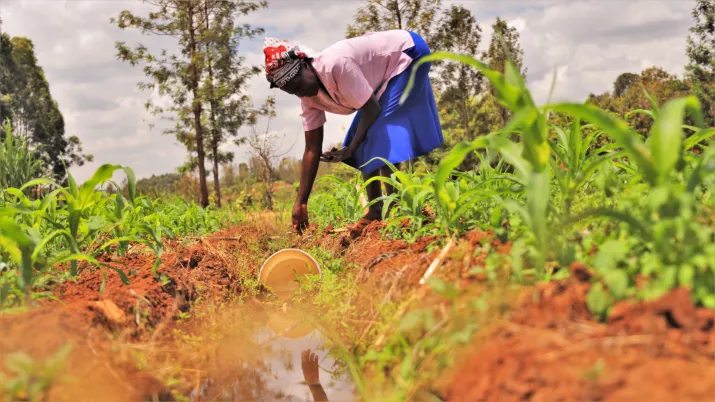Share the page
Sustainable finance in action: when financial players transform their business model
Published on
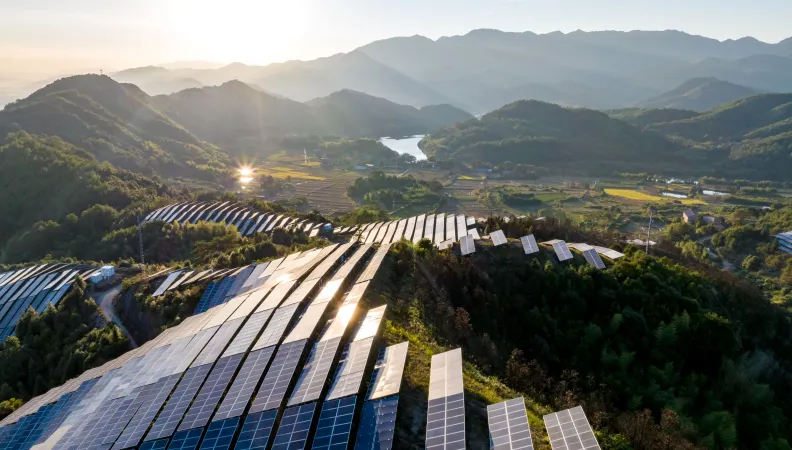
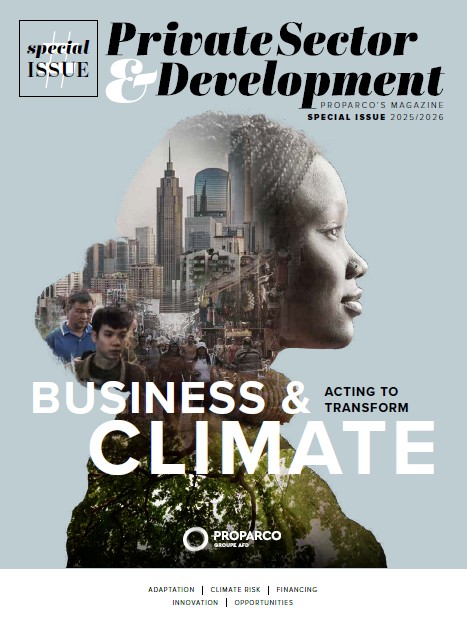
Private Sector & Development - Business & Climate: Acting to transform
Proparco has published a new edition of its Private Sector & Development magazine, focusing on the strategic role of the private sector and financial institutions in tackling the climate emergency.
To bolster their action in favour of climate change mitigation and adaptation to its adverse effects, financial institutions are reorganising. They are rethinking their processes, products and conditions of access to their services in order to amplify decarbonisation. Everybody involved in this process shares common ground: a strong internal commitment, the conviction that this new framework offers real business opportunities, and recognition of the essential role of development finance institutions (DFIs) in scaling up. Priority is often given to small and medium-sized enterprises, which lie at the heart of the real economy.
Despite very different economic, social, geographical and geopolitical contexts, many financial institutions are adopting similar approaches to offering responsible financing products that are both practical and commercially viable. The importance of internal commitment is a common feature of all these institutions. “During the Covid period, First Rand decided to incorporate shared prosperity into its strategic framework. - For the management team, it was becoming increasingly difficult to say ‘we are prospering’ when our country was not”, explains Bhulesh Singh, Treasurer of South African group First Rand Bank.
The bank therefore reviewed its priorities in order to contribute more effectively to the well-being of society, and “no longer just generate profit. We’re the custodian of an enormous amount of savings of citizens of the country. And then we also asked ourselves, “what would society want us to do with all these savings?”
In-house testing and acculturation
In Costa Rica, Banco Promerica’s trajectory is based on a two-pronged approach: a strong commitment from senior management and the mobilisation of local green champions. As Michelle Espinach, Sustainable Bank Manager, Banco Promerica Costa Rica, explains: “We actually started engaging in green financing before there was a word for it. There was no taxonomy in our countries. Development finance institutions (DFIs) like Proparco helped us all the way.” The decision to sign up to the Net Zero Banking Alliance1 was a turning point: “The banks that signed this agreement took risks, because decarbonising a portfolio is a complex task. But a more responsible customer is also a more profitable, and therefore a more solvent one. Everyone’s wins.” Michelle Espinach calls on financial institutions to take a more proactive role: “We have to use the power we have to finance the economy for the common good. But if all banks decided to no longer finance the big polluters and certain polluting vehicles, that would change our country instantly.”
The banks believe that to sell the idea of sustainability, you have to embody it. Alex Mantua, CEO of ProCredit in Georgia, believes that, “If everyone in the institution understands what sustainability is, then you can sell it. Otherwise, you can’t break into the market.” This group, whose assets are mainly invested in small and medium-sized enterprises in the country, has opted to train its 450 employees every year since 2010: “Once is not enough, the process has to be repeated.”
At the same time, the bank itself first deployed the solutions it wished to market. “In 2015 or 2016, when I asked colleagues to come up with a solar panel project for head office, the payback period was 25 years. We said, it’s not possible. Then the cost came down, and in 2019-2020 we re-evaluated the payback period. Once it had fallen to 9 years, we said now we’re going to do it.” Internal testing made the offer more convincing for customers, even though the IRR still had to be reduced to a maximum of 7 years.
By incorporating subsidies and reduced interest rates, ProCredit calibrated its model and launched an eco-loan for installing solar panels for SMEs, with an automatic approval process based on financial data and available surface area. It has also encouraged electromobility by first replacing its own fleet and then facilitating loans to facilitate access to it.
Accessible products to facilitate decarbonisation
The Kenya Commercial Bank (KCB) group, a member of the Net Zero Banking Alliance, is demonstrating the same proactive mindset. As Eric Naivasha, Head of Sustainable Finance for the group, explains, KCB has initially identified three priority areas for action: transport, commercial real estate and commercial lending. “90% of our emissions come from lorries. We therefore developed a decarbonisation strategy per segment: two-wheelers, light vehicles, heavy goods vehicles, etc.” KCB’s trajectory forecasts that 60% of new vehicle financing will be for electric vehicles by 2040, with a total halt to loans for combustion engine vehicles after that. More broadly, the group is aiming for a 25% green portfolio within two years, representing USD 5-10 billion in investments. But Eric Naivasha stresses that success depends less on plans than on human expertise. “Until the client-facing person understands that strategy, then it just remains some nice piece of paper in our files. We need to train not only our staff, but also our customers, right down to the small farmer who is unaware that climate change is reducing his harvests.” For him, the transition must become a lever for opportunity and it concerns irrigation and greenhouses as much as the overall deployment of resilient agriculture.
However, for it to fully play this role, sustainable financing must be made accessible (locally), and this is another requirement common to all institutions. Sterling Bank’s actions in Nigeria illustrate this: in 2024, it financed the purchase of a fleet of 120 electric tricycles to support female entrepreneurship and mobility in Kano, a city with a population of 14 million. Abubakar Suleiman, CEO of Sterling Bank explains that, “the aim was to provide women with a means of transport that they not only own but have co-created, that is both economically viable and improves the local economy.” Today, the fleet, which is equipped with interchangeable solar-powered batteries, has clocked up a total of 450,000 kilometres. Abubakar calculates that “In three days, a driver can earn the equivalent of a minimum monthly wage. “All of this represents an investment of only USD 400,000 to USD 500,000. We have already avoided the emission of 26.1 tonnes of CO₂ with only 120 tricycles. Imagine the impact with tens of thousands; on a large scale? – and this won’t require any subsidies.”
Towards a sustainable transition at scale
And as the banks point out, scaling up requires rethinking objectives, organisations and operational tools. In the face of global challenges and their local contexts, the energy transition is not a mere formality: it is a requirement for staying in business as much as a lever for competitiveness.
But this requires new business strategies, careful risk management and structural transformation of the economies they finance. For Rachael Antwi, Head of Sustainability for Ecobank group, the bank’s record reflects its commitment to climate finance: “It’s not a question of compliance, but of survival – for the bank and for the economies in which we invest.” Ecobank has launched its own initiative, which includes portfolio analysis, a decarbonisation plan with a coal exit policy, and targeting sectors with high green potential. “Our goal is to mobilise USD 5 billion in six or seven years for climate finance.” This strategy is based on a continuous learning approach: internal training, data audits, and the creation of an ad hoc digital tool to analyse and monitor physical and transition risks. Rachael Antwi also highlights the difficulty (and importance) of obtaining reliable data in Africa and the need for an integrated reporting system.
Eric Campos, Crédit Agricole S.A.’s Chief Sustainability and Impact Officer, explains the complexity of sustainable development in a group with assets exceeding €1 trillion. “The challenge is not to green our assets, but to green the economy.” Since 2019, the group’s climate strategy has been supported by a Scientific Advisory Committee and the direct commitment of the Chairman and Chief Executive Officer: “Without support from senior management, don’t even try to implement a climate strategy. It’s absolutely impossible.”The challenge is twofold: maintaining financial performance while taking responsibility for carbon performance. Between 2020 and 2024, the bank increased its investments in renewable energies by 140% and reduced those in fossil fuels by 40%: “It is absolutely imperative that we turn climate constraints into business opportunities.”
From promise to plan: building a credible transition
Taking action on climate mitigation requires a clear strategy and a structured plan to rethink a business’s development trajectory and its internal tradeoffs. As Ilaria Balletto, head of the ACT (Assessing Low Carbon Transition) initiative at ADEME (the French Agency for Ecological Transition) points out, “a transition plan is not a side strategy. It is not a CSR add-on. It is a way for a company to transform its business model to align with a strong 2050 net zero target”. In France, this framework, which is supported by ADEME (French Agency for the Ecological Transition), helps companies assess the feasibility of their climate trajectory by structuring coherent objectives, dedicated resources and verifiable indicators.
The Engie Group has used it to build a plan that is aligned with its goal of achieving carbon neutrality by 2045. As Adrien Koenig, Head of Structured Finance at Engie explains, “We use our transition plan to define the key performance indicators (KPIs) for our financing. Today, we have over €10 billion of financing tied to clear emissions targets, with yearly benchmarks.”
In Georgia, TBC Bank has taken a gradual approach. Maka Bochorishvili, Head of CSR at TBC tells us that, “Even though we didn’t know how to measure the emissions of our portfolio, we said let’s something that our customers can understand. So first of all, we set a 30% sustainability target.” To achieve this target, the bank has partnered its most emissions-intensive industrial customers, including helping them to design their products, thanks to a team of engineers integrated into the institution.
In Africa, where emissions avoidance takes precedence over reduction, Helios – a private equity firm focused on Africa – has developed a specific local approach. “We have put together a team to measure and compare emissions according to global standards, adapting them to Africa,” explains Tavraj Banga, Partner at Helios Investment Partners. A Nigerian tomato processing plant, which was previously dependent on Chinese imports, was thus able to reorganise its entire supply chain using local suppliers. This strategic repositioning reduced its carbon footprint, secured supplies during the pandemic and enhanced profitability. This is a concrete example of how climate transition can act as an economic lever.
Going beyond traditional approaches
Proactive and determined, financial players who are committed to climate finance and its concrete deployment still stress the advantages of being able to rely on development finance institutions (DFIs) such as Proparco. The testimony of Hawshi Shawa, Chairman of the Bank of Palestine Group, is very interesting in this respect: “Thanks to the catalytic effect of AFD and Proparco programmes, we have been able to lend more in a difficult context.” The Sunref I & II projects have financed solar farms ranging between 0.5 and 5 MW, and since 2018, more than USD 50 million in green loans have been granted to SMEs to improve their energy efficiency. “This illustrates the scale effect made possible with the right programmes: a risk reduction component, a subsidy component, and above all technical assistance to train our teams, raise customer awareness, and encourage them to adopt these solutions,” he adds.
Beyond that, regardless of their location, all banks support innovation (through venture capital funds, acceleration hubs, etc.) by increasingly encouraging start-ups committed to sustainable development. The aim is to unleash the entrepreneurial dynamism that is often stymied by traditional banking processes, in order to further accelerate the battle against climate change and give concrete impetus to sustainable development.
In Nigeria, Proparco is helping First Bank develop a climate strategy
In 2022, Proparco approved a loan and two years’ worth of technical assistance for First Bank Nigeria to help integrate key climate issues into its strategy and operations. This enabled the Bank to launch a number of parallel initiatives:
- estimation of its (operational and financial) greenhouse gas emissions (GHG)
- analysis of the physical and transition climate risks to which the portfolio is exposed
- analysis of the major opportunities for financing climate mitigation in the Nigerian market
- staff training
- integrating the different climate challenges into its existing procedures and strategies
Thanks to these efforts, First Bank now has a baseline for its operational and financial emissions on which it can base its decarbonisation objectives. It has also been able to develop staff climate training modules together with a climate risk analysis framework for its operations. The Bank has also been able to use this work to begin reflections concerning the development of green finance products or the role that it can play in the transition of its most emissions-intensive customers.
This pilot programme, involving a number of teams from the Bank, has highlighted the stages required to integrate climate challenges into the organization. It has also shown that it is essential – and quickly very profitable – to do so.
Analysis
E-mobility: using debt to scale up
Scaling up the electric mobility sector requires the use of debt financing. This is the message conveyed by three representatives of major investors in vehicle decarbonisation in Africa, India and Lat...
Published on November 20 2025
Further reading
In Sub-Saharan Africa, the ARAF fund is strengthening the climate resilience of smallholder farmers
Published on November 12 2025
